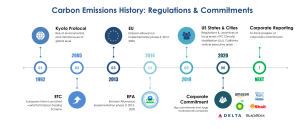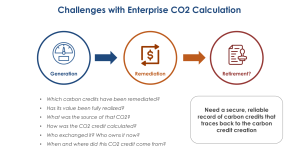The Other Carbon Problem – No One Knows the True Numbers
The Other Carbon Problem – No One Knows the True Numbers

In response to shifting consumer preferences and expanding environmental legislation, many large companies like Amazon, BP and Delta are making strong commitments and taking the necessary steps to reduce their carbon emissions.

Carbon Emission Statements Can’t Really be Tracked.
The means of tracking carbon outputs, however, have so far been lackluster at best. This is due to numerous factors that complicate the measurement and tracking process, including:
- the multitude of data sources that exist throughout the supply chain
- the regulations and emissions standards that vary, in some cases drastically, from one region to the next
- the diversity of formulas, calculations and models to measure carbon emission
For a global company trying to meet standards and accurately track and attribute emissions for its operations worldwide, this is nearly impossible to do efficiently with current tracking methods.

The main method organizations currently use to measure and track emissions.
Measuring and tracking emissions involves manual data entry into spreadsheets, can produce inaccurate and difficult to prove results. This forces companies to overestimate their emissions numbers to avoid regulatory penalties.
This means we do not currently have an accurate measure of carbon levels being released into the atmosphere, which is troubling. It’s impossible to know if the world is on track to cut emissions by the level scientists have indicated is needed. That was agreed to in treaties like The Paris Agreement if we can’t fully trust the data that companies are reporting.
A new method of tracking is needed – the status quo is no longer good enough. This will require companies to embrace a new set of technology tools that are already reshaping many other industries. A more accurate and efficient tracking process can emerge through a combination of connected IoT, digital twins, and blockchain.
The emissions status quo
Many companies employ the current method when tracking their carbon outputs is quite simple in design – inputting emissions data into spreadsheets where the data can be tracked. These spreadsheets are compiled at operational points worldwide and sent to the CFO office or a similar C-Suite executive (e.g., COO, CIO, CTO, CDO) to be parsed, sorted, and then reported to the various regulatory bodies. This is not an easy task since if any errors, even accidental, are caught upon audit, the company will face fines.
The fact is, at many companies, the C-level executive can’t fully trust the emissions numbers that are reported to them – not because they lack faith in the team doing the collecting, but because there is no way to guarantee that the numbers have been accurately recorded at each step of the process. Most organizations have vast operational networks, spanning continents, with hundreds or even thousands of employees involved in the emissions tracking process at one point or another. It’s simply not feasible to trust that everything was tracked with 100 percent accuracy; any errors pose far too big a risk.
Rather than risking fines if the numbers turn out to be inaccurate upon audit, many companies are forced to systematically overestimate their carbon emissions. In other words, they report carbon savings lower than they think are true as a protective measure, resulting in missed remediation credits they are entitled to claim and distorted the carbon output data that governments and scientists worldwide are using to make policy recommendations and decisions.
A new path forward
The current method for tracking carbon emissions has proven to be too time-consuming, inaccurate, and difficult to be sustainable in a business environment that is only increasing in complexity and scale.
Companies need to embrace a new way of tracking emissions to maximize their incentives and to give regulatory bodies a more accurate view of the real state of global carbon outputs. Several innovative technologies can work in conjunction with one another to aid in this process – edge computing, IoT, digital twin, AI and blockchain.
- IoT and edge computing: IoT is already transforming the energy sector in many ways, whether it be reducing equipment downtime or improving maintenance processes. When it comes to tracking carbon emissions, connected sensors can vastly improve the data collection process. These devices allow emissions to be monitored remotely and collected with ease, no matter where in the world a piece of carbon-emitting equipment is located. Advances in edge computing make it possible for data to be quickly collected and recorded no matter the sensor’s location, offering companies a reliable data collection method that they can implement in any region.
- Digital twins: The step following data collection is modeling the carbon outputs in real-time to be monitored and recorded at a central location. A technology called digital twin is vital here. It creates a digital representation of a manufacturing plant, building, etc., in real-time, using the IoT network’s data. This gives unprecedented insights into the current rate of carbon emissions for each location being monitored and also creates a data source for next-gen predictive analytics (i.e., AI) to model future emissions. With outputs varying throughout the year, this level of insight can vastly improve the company’s ability to project their emissions levels, so they have a real-time estimate about whether they’re on track to hit emissions goals.
- Blockchain: From here, companies need a reliable place to record the emissions data that will be accurate and easily referenced in case of an audit. Blockchain fits the bill. It’s an immutable ledger – meaning that the data inputted from IoT sensors and digital twins can be trusted as fully unaltered, giving the C-level executive proof that data shared with them is factual and accurate. Using a blockchain also allows companies to navigate the regulatory mess that comes with operating in numerous jurisdictions worldwide, as the time and location data can be embedded right alongside the emissions data, tying it together accurately and reliably that would stand up during an audit.
Is there an actual source for emission-truth? No.
This single source of truth for all company data lets the CFO report with confidence and ultimately claim more of the credits the organization is entitled to. Blockchain also provides the means to take the next-gen technology towards efficiency by tokenizing the ecological savings that can then prove regulatory compliance.
While embracing these new technologies within a company will certainly save time and reduce risks for any company that adopts them, we can also make a dent in the larger issue – the need for an accurate picture of global carbon emissions – by adopting industry standards at a wider scale.
Companies need to work together towards the greater good, committing to developing a standardized system of carbon emissions tracking and reporting that will ensure accuracy across the board. They should also look to standardize carbon credits in the form of tokenized assets on the blockchain. It’s only with this level of coordination and collaboration that the world can move closer to its goals of reducing outputs.
Image Credit: pixaby; pexels
The post The Other Carbon Problem – No One Knows the True Numbers appeared first on ReadWrite.
(54)

